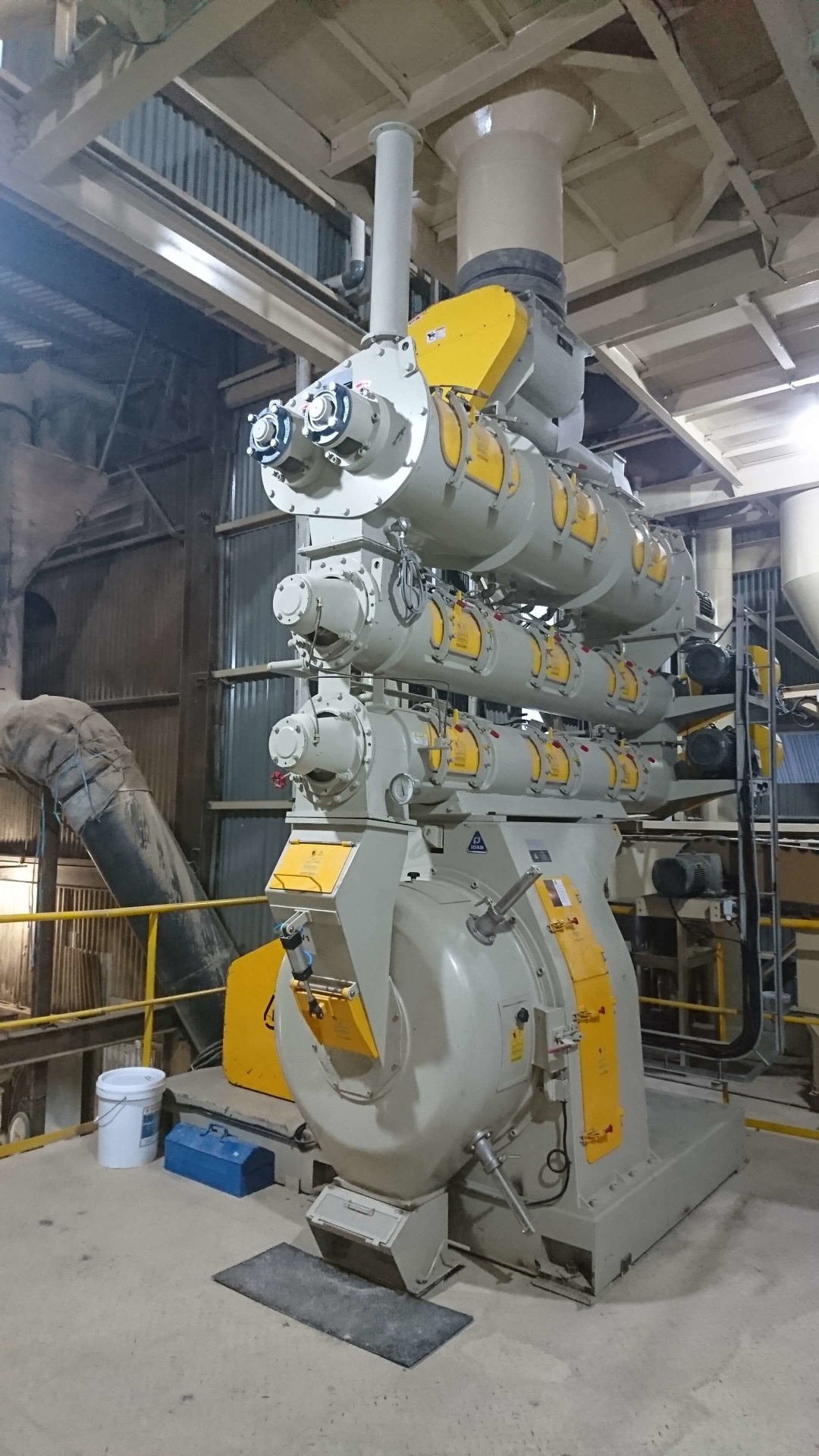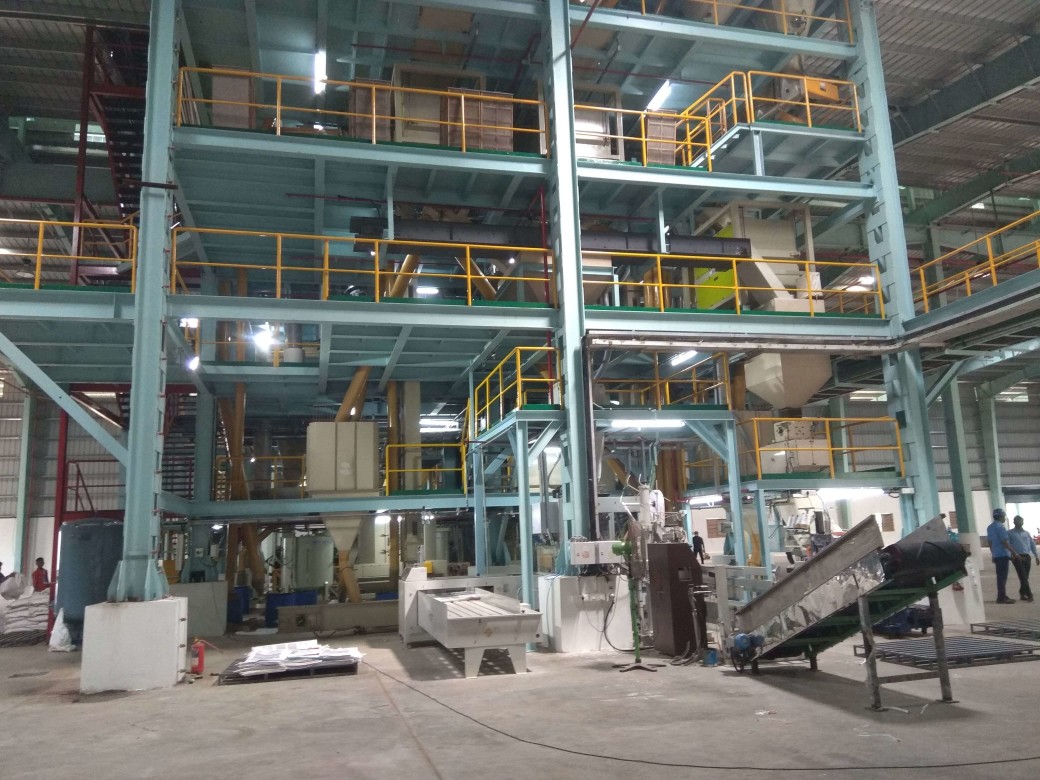Shrimp feed can be produced by two methods, pelleting or extrusion, depending on the dietary of the shrimp species. For the majority of the markets in Asia, pelleting solutions are still highly recommended. This page will give a comprehensive description of the pellet mill system. If you are interested to know more about the extrusion process, you can find more in fish feed solution.

Raw Material
The raw material for shrimp feed consists of coarse and powdery material
Pre-grinding
Optional step for coarse material.
Pre-grinding will lower the
energy needed for ultra-fine grinding.
Daily Tank Storage
In general, the shrimp feed line will utilize 12 raw material bins.
Every bin will be filled with around 5-6 batches of material.
Dosing and Weighing
The material will be dosed based on the formula.
In the shrimp
feed line, usually material will be processed by batch.
Post-grinding
Post-grinding is the final size reduction in the system.
It is common to use a pulverizer for producing ultra-fine powder.
Wet mixing
Water, oil, and other liquid material will be added.
This will help to hydrate the material before the cooking
process.
Pelleting
Pelleting starts with pre-conditioning, adding steam to further hydrate, and cooking the material before entering the pelleting chamber to be formed into pellets.
Post-conditioning
Post-conditioning utilizes pellet inner heat added with the heat (by steam or electrical) to prolong cooking and avoid condensation inside the chamber.
Drying
In "High Moisture Pelleting", this is a very crucial step to lower the moisture on the pellets.
Cooling
Cooling utilizes ambient air to cool down the hot pellet from the
post-conditioner (or dryer).
Thorough cooling is needed to prevent condensation inside the
packaging.
Pelleted Feed
Crumbling
Crumbling is needed to reduce pellets' size into smaller particles. This crumbled feed is needed for the shrimp post-larvae period
Packing
Packing gives protection to the pellets and also give easiness to handle and transport to customer's hand

Pelleting process description for aquatic feeds
Cooler lowers the temperature of the hot pellets to + 3°C of room temperature by utilizing the ambient air.
All pellets will go through a vibration sieve to remove any irregular pellets or dust.
Finished pellets will be placed in bags or other transportation vessels to the reseller or customer site.
Pellets are conveyed into storage bins before either being packaged or being turned into crumble in the crumbling machine. Pellets can be processed by crumblers to produce smaller pellets as No.1, No.2, and No.3 products. (Sizes between 20 to 60 mesh) Fines will be recycled to the pellet mill section for re-use and undesired bigger pellets that pass through the sieve will be re-crumbled again.

Features and Benefits of IDAH Process Design and Equipment
IDAH firmly believes in a strategy of design fit for purpose. We recognize the constraints our customers face with rising ingredient costs, energy costs, and overheads costs, yet in the face of these challenges, it is still expected that high-quality products be supplied into a very competitive market. Our design philosophy is to work continuously to refine and improve processes and equipment to maximize the success of our customers. The following describes some of the features and benefits resulting from this philosophy.
We design our equipment for continuous operations and fulfill the expectation for minimal downtime. Our mission is to see our equipment still working years after installation, with only maintenance required being routine maintenance caused by normal fair wear and tear.
Two perspectives are influencing the formulation: culturing performances and efficiency of the machinery. For example, choosing the right starch source (types of flour) is essential. Inappropriate starch sources will lower the steam incorporation level and causes jams at the pellet mills. Fat and moisture content play inseparable roles in the hammer mill and pulverizer throughput. Formulation with high fiber content not only increases the risk of broken pellets, lowering the water stability of the pellets. High fiber content also increases the wear of all machinery in the process. Reducing the use-life of the parts such as the hammers, screens, and dies.
We firmly believe in the benefit of even particle reduction to ultra-fine powder. The typical target is to reach more than 95% passing through a 60 mesh screen. It is impossible to efficiently produce small-size products with size 2.0 mm and below without this ultra-fine grind process. Ultra-fine grinding will increase production efficiency and end product quality during the production of larger-size products. It will also open the possibility to utilize less expensive starchy ingredients. IDAH understands that many production practitioners might worry about the extra energy cost of utilizing a pulverizer, which is why we designed a revolutionary pulverizer that runs at much lower energy costs. The ability to substitute with cheaper ingredients cost will compensate for the small extra energy requirement of the pulverizer. The ultra-fine raw material will produce smooth, shiny, and water-stable products.
We always recommend the pre-hydration in pre-pelleting mixers. The hydration of dry ingredients at this production stage improves the throughput, lowers energy costs, and increases product quality. To evenly feed the pre-hydrated mix to the pellet mill, we supply an activated semi-cylindrical hopper system, with slowly rotating paddles.
The independent drive on each shaft of the IDAH twin shaft lowers power consumption and noise. The paddles' reverse rotation allows completely emptying the chamber. The misting steam and water injectors further improve conditioner performance. The following conditioner system used steam jacketed (or heat jacketed) to create a homogenous mix with little to no free water. Insufficient pre-conditioning will cause cracks on the pellet surface and create dust fines.
IDAH pellet mills are born from years of experience and continuous improvements to ensure high production efficiency at the lowest cost. IDAH has standardized the pellet die and the roller shell for aqua feed production. The compression ratio of our pellet die is specially designed to ensure compact and tough pellets with higher PDI. The roller shells are designed individually for each different hole size. IDAH has been producing machinery for aqua feed since 1974. IDAH pellet mill is well-known because we consider the design of conditioning. The “High The moisture Pelleting” method can be achieved through our advanced pre-conditioning technology. Careful control in the incorporation of heat, moisture, and time provides sufficient cooking for the production of premium quality feeds with good water stability to the market. In addition to altering the product quality, sufficient pre-conditioning also reduces wear out of the parts.
IDAH Post-conditioner was proposed and invented by IDAH in the 1970s and has since become a standard in pellet mill systems in Asia. Post-conditioning is the most effective and economic method to achieve high-quality pellets. The quality of the pellets is determined by how well the water stability and the nutrient retention when pellets are fed to the water.
The latest design of the post-conditioner system is composed of a KB-series conditioning cooker and a T-series dryer. In the post-conditioning system, the hot pellets enter the steam- or electrical-heated retention chamber to keep material in a high-temperature environment and prevent condensation inside the post-conditioner. This step ensures optimum starch cooking on a considerable proportion of starch contained in the shrimp feed for improving pellet quality (hardness and durability) and water stability. The next step is the drying process where products tumble through multiple decks at thin bed depth. Air circulation and rotating screens inside the T-series dryer are exclusively designed based on shrimp feed properties which ensure pellets are made without cracks, with fewer fines, high water stability, and smoother surface.

The counterflow cooler is used for cooling pellet and extrudate. Warm (hot) pellets get into the cooling chamber, the suction fan will transport out the air inside the chamber, and fresh ambient air will enter the chamber from the bottom, promoting pellet cooling action. When pellets are accumulated and touch the high-level limit sensor, a pneumatic discharge swivel valve will operate immediately to discharge the products. Counterflow air heat exchange ensures to achieve high cooling efficiency.
IDAH crumbler series is designed for high capacity and highly efficient particle reduction. Three types are available for every industry application. Every crumbler is equipped with the feeder on the top, to control the throughput of the product. The roll gap is easily adjustable to achieve the required granulation.
Specification of Pellet Mills (for Shrimp feed)
| Model | PM-42SA | PM-51SA | PM-53SA | PM-53F | PM-635D |
| Main Motor (HP) | 100 | 150 | 200 | 215 | 300 |
| Operation Capacity1 (t/h) | 1.3-1.5 | 2.3-25 | 3.0-3.5 | 3.5-4.0 | 4.5-5.0 |
| Operation Capacity2 (t/h) | 3.0-4.0 | 4.0-5.0 | 5.0-6.0 | 6.0-8.0 | 9.0-10.0 |
Note:
1) Shrimp Feed, pellet die hole size Ø 2.0 mm
2) Sinking Fish Feed, pellet die hole size Ø 3.0 mm

